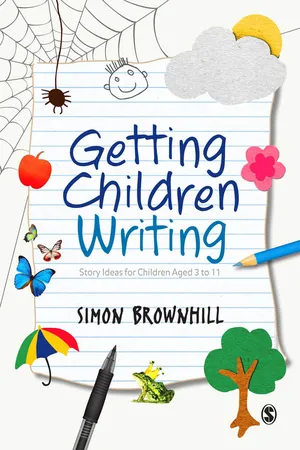
- 304 pages
- English
- ePUB (mobile friendly)
- Available on iOS & Android
About This Book
?This is a fantastic book which provides creative and practical suggestions of how to engage all children in writing?
- Sarah Martin-Denham, Senior Lecturer in Primary Education, University of Sunderland
This book is a practical guide designed to stimulate story writing in the early years and primary classroom. It offers a collection of novel and effective Ideas which can be used by educators to energise, excite and motivate children to willingly write stories across the 3-11 age phase.
Each chapter offers creative and innovative Ideas to get children writing stories, including:
- how to help children ?see the point? of story writing
- how speaking and listening, reading and phonics can be utilised to enhance written stories
- how technology can facilitate refreshing story writing
- how story writing can be physically interactive.
By combining theory with practice, this book is ideal for those training to teach the 3 to 11 age range, those beginning their teaching career, and those who are established in their professional role.
Simon Brownhill is Senior Teaching Associate at the University of Cambridge.
Frequently asked questions
Information
1
‘Pen-to-Paper’ stories
Taking a Closer Look at ‘Blank Minds’
- Teachers are reminded that children’s writing output is influenced by their age, their stage of writing development (see Introduction, p. 12), and whether they have any SEND which may contribute in some way to ‘a lack of basic skill’ noted in their written work (e.g. limited language proficiency or a physical disability). Teachers should ensure that they have high writing expectations of their children but that these should be realistic in relation to the children’s actual capabilities. These expectations can be monitored through the use of regular assessment and ‘next steps’ targets (APP – see http://tinyurl.com/d7vx65r).
- There are children in our classrooms who lack writing commitment; many teachers would suggest that this typically relates to boys in their class (Safford et al., 2004), particularly in light of the results of national testing (see DfE, 2012c). Writing commitment is important for all writers, irrespective of their gender or age. There are numerous reasons why children may lack dedication to their writing; these include:
- having other curriculum strengths/interests;
- finding that they do not have enough time to actually write in class; or
- having too many distractions around them (e.g. their friends).
- Set writing targets that are specific, measurable, achievable, realistic and time-related (SMART) for children to work towards and achieve (see http://tinyurl.com/75uzh94 for information about the meaning and setting of SMART targets).
- Ensure that sufficient time is offered on the timetable for quality writing activity each day.
- Offer children a choice about their writing – what they are going to write about, what they are going to write on (paper, computers, acetates) and where they are going to write (inside, outside, on the floor, next to friends).
- Offer frequent and purposeful praise for both children’s written output and their efforts.
- Use rewards to acknowledge children’s increasing levels of writing commitment (see Cremin et al., 2006 and Nolen, 2007 for further ideas).
- ‘Procedural blocks [that] arise when the writer’s mind has gone blank and it is not clear what should be written next’;
- Psychological blocks that occur when ‘the writing task appears too difficult, or the audience is perceived as a threatening one’; and
- Physical blocks that refer to ‘the sheer physical demands of the writing process [which] can inhibit the young writer from completing the task’.
Table of contents
- Cover Page
- Title Page
- Copyright
- Contents
- Acknowledgements
- About the Author
- Glossary/Abbreviations
- Age Bandings
- Introduction
- 1 ‘Pen-to-Paper’ Stories
- 2 ‘Design and Make’ Stories
- 3 ‘Being’ Stories
- 4 ‘Craft’ Stories
- 5 ‘Engaging’ Stories
- 6 ‘Technology’ Stories
- 7 ‘Location’ Stories
- 8 ‘Boys’’ Stories
- 9 ‘Creative’ Stories
- 10 ‘Random’ Stories
- Appendices
- References
- Index